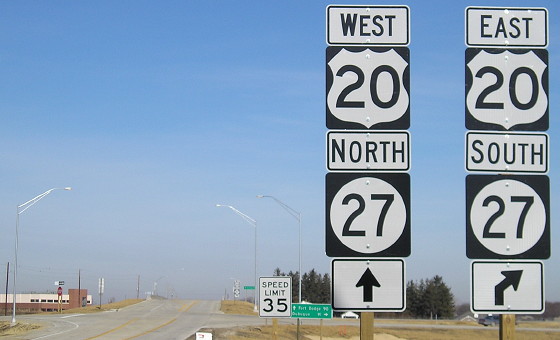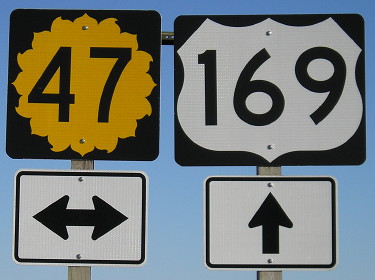
Nov. 27, 2006: The then-new Ansborough Avenue interchange in Waterloo shows two signage trends that have become and are becoming standard in Iowa in the 2010s: Larger initial letters and skinny, squat arrows.
The first appearance of non-Iowa-style traffic arrows was eight years ago at the new Ansborough Avenue exit on US 20 in Waterloo. I thought they were contractor-issued, and they likely were, and no other instances appeared. Then, when new US 20 opened in Sac County, all the shields along the IA 196 extension were wide, three-digit versions. Finally, last year, when the US 63-IA 58 intersection was completely bulldozed and reconfigured into a T, the squat arrows appeared again.

June 3, 2014: New signs at the south end of IA 58 in Hudson. Note FHWA Series D font in use for US 63 (ditto US 20 above), which is pretty rare in Iowa but the rule in Minnesota and Missouri. Also note the lack of a thin white border on the shields.
They aren’t a mistake. Small arrows and wide shields for three-digits roads are going to be standard operating procedure for Iowa going forward. In other words…welcome to Kansas.

October 8, 2008: This intersection near Thayer in southeast Kansas shows the sign shapes that are coming to Iowa. Only one three-digit US highway in Iowa (275) does not contain a 1, and the skinny FHWA Series B works just fine, but the wide shields are coming just the same. The numerals above are Series C (47) and D (169). The number 47 hasn’t been used in Iowa since 1980.
If you look closely at the photos, you can see another wrinkle: The arrow signs are slightly less wide (by 3 inches) than the square shields above them. That’s just enough to notice at highway speed.
These changes are being made to conform to the 2009 MUTCD. Iowa’s arrows, which used squares for perpendicular directions or angles and the same long arrow for “ahead” as left and right, will be phased out. The “old” style will be around for years to come, but get progressively rarer. They’ll live on in my photos, at least.
